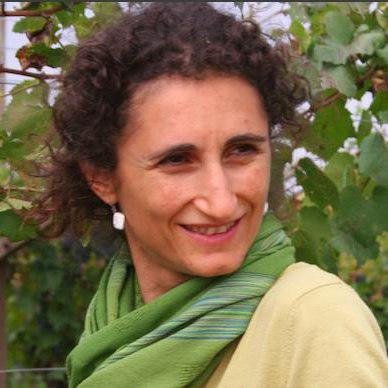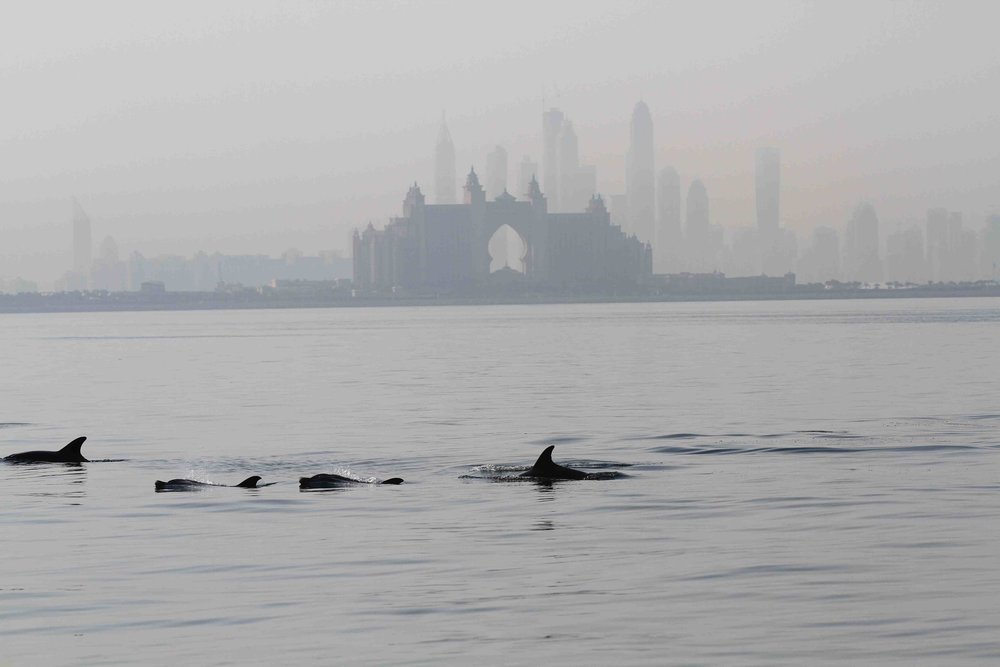Dolphins, the most appreciated marine mammals in Persian Gulf

The dolphins are highly social, intelligent animals. They form close, cooperative “friendships” with each other, and some individuals will even seek out human contact.
They are of the order Odontoceti and, unlike the whales have numerous teeth (up to 260), which are all alike and grow only once.
On the same subject the Tehran Times conducted an interview with Dr. Ada Natoli, project director of UAE dolphin project. UAE dolphin project is an initiative project that provides first scientific information for at least a small area or the coastal waters in UAE. The project raises public awareness among the local communities and the Persian Gulf countries.
Ada is a specialist in population genetics with a passionate interest in conservation of species. Her main interests are investigating the evolutionary mechanisms generating population structure, and supporting conservation and management programs. She is a member of the IUCN SSC Cetacean Specialist Group and she has participated to the International Whaling Commission as member of the Italian delegation and invited participant. She is involved in the conservation of cetaceans in the ACCOBAMS area.
[The IUCN SSC (Species Survival Commission) is a special commission operated by the International Union for Conservation of Nature. The commission's "major role is to provide information to IUCN on biodiversity conservation, the inherent value of species, their role in ecosystem health and functioning, the provision of ecosystem services, and their support to human livelihoods.]
[ACCOBAMS, the Agreement on the Conservation of cetaceans in the Black Sea, Mediterranean Sea and contiguous Atlantic area is ‘a cooperative tool for the conservation of marine biodiversity in the Mediterranean and Black Seas’.]

Q: How did UAE dolphin project first spark your interest?
A: The UAE dolphin project initiative stems from my personal scientific background and the realization that very little information is available about whales and dolphins in the [Persian] Gulf, and in the UAE. No dedicated survey on coastal dolphins to assess their status has ever been conducted in UAE or in other regions of the [Persian] Gulf. Especially considering the dramatic change that the coastal areas have experienced in the past decades, there is an increasing necessity to gather scientific baseline information on the local species that can support their conservation and the conservation of the whole marine environment. Species can disappeared unnoticed from a region if nothing is known about them. As much as dolphins are iconic animals, more importantly they are considered ecological indicators of the health of the marine environment, as they sit at the top of the marine food chain. So studying dolphin populations can provide an indication of the status of the marine ecosystem, and protecting dolphins can immediately result in protecting all the species below their trophic level.
These considerations prompted me to start the UAE dolphin project initiative, to provide first scientific information for at least a small area or the coastal waters in UAE, raise public awareness among the local communities and the [Persian] Gulf countries.
The mass media always portraits dolphins as the friendly smiling animal. Wild dolphins can actually pose a risk to humans simply because are wild animals! I don’t recommend swimming with wild dolphins. Think! A dolphin is on average 250kg, it is a carnivore and has lots of teeth! Would you still clap your hands and whistle to drag its attention and swim with it?
Q: Would you please tell me more about preliminary results?
A: The results are encouraging:
1) Public engagement and awareness: we proved that the public can make a difference and provide invaluable data to help the research by simply reporting their sightings! Centralizing the information and making it available to the public is also crucial to raise awareness among all stakeholders and the public.
2) Research: Along the Dubai coastline, we confirmed the presence of three species of dolphins: the Indo-Pacific bottlenose, humpback dolphin and the finless porpoise. This is already a great result especially confirming the presence of the finless porpoise that is considered “vulnerable” by the IUCN Red List.
Q: What is your general assessment about Cetacean populations in Persian Gulf? Do you think habitat structure had any effect on their behaviors or even on genetic diversity?
A: It is very difficult to assess without data! From my experience I see the Persian Gulf as an extremely interesting marine ecosystem. The age of the Persian Gulf is comparable to the one of the Black Sea and for what regards dolphins, the Black Sea populations show extreme differentiation both at morphological and genetic level to the extent that they are considered subspecies. At the moment we don’t have enough data from this region to make such assessment, but I wouldn’t be surprise if the local dolphin population will be differentiated from the ones from the neighboring Indian Ocean. Also it would be extremely interesting to assess the population structure within the Persian Gulf by comparing samples and data from different areas.
Q: Would you like to participate with Iranian specialists to have a better viewpoint? How these participations can occur in your opinion?
A: I will be delighted to participate with the Iranian specialists to any initiative that will improve raising awareness about cetaceans and increasing the understanding of these species in the [Persian] Gulf. I believe that communication and collaboration is the winning design to efficiency and great results. Happy to discuss ideas!

Q: How much normal people can help in gathering basic information such as in transect surveys or even for photo-identification?
A: Nowadays with the support of such easily and cheap technology such as mobile phones, “citizen science” can really make a difference in gathering baseline information on species. One of the main targets of the UAE dolphin project initiative is to actively involve the public in helping the research. The “Report a Sighting” system has now received over 186 sighting from different areas of the UAE and also neighboring countries. The data is freely accessible to the public through the project sighting map. Especially where there is no baseline information these data are crucial. As we started to compile our photo-identification catalogue of the identifiable individuals, sending pictures of the dolphins’ encounters, the public can also provide great information to enable us to track the individual’s movements. Really everybody can help! The public can also be involved directly in the survey by joining the research team as volunteer to conduct the survey.
Q: Most of people don’t know dolphins can be dangerous. In most cases we see adults and children who shake their hands to attract dolphins, what is your suggestion for them and for their leaders?
A: The mass media always portraits dolphins as the friendly smiling animal. Wild dolphins can actually pose a risk to humans simply because are wild animals! I don’t recommend swimming with wild dolphins. Think! A dolphin is on average 250kg, it is a carnivore and has lots of teeth! Would you still clap your hands and whistle to drag its attention and swim with it?
It would be great to see the Iranian public joining the “Report a sighting” campaign. The more sightings are reported the stronger can be the cause to carry on more detailed investigation to assess the status of the Iranian coastal dolphin populations. Q: How fisheries can help cetaceans? It means how can decrease the number of stranding dolphins or whales?
A: Generally fish presence and dolphins are pretty connected. If there is a healthy dolphin population, generally is an indication that also the fish population is healthy and in turns fisheries. By-catch is a problem in many countries. Stranding is another chapter. There can be many causes because a cetacean cast ashore. The establishment of a stranding network and a systematic collection of information on the stranded animals is crucial to verify the cause of death and if found linked to the fishing activity, alternatives can be proposed to minimize the risk.
Q: Why countries in the region must be aware and sensible about cetacean populations?
A: Every natural resource is part of the heritage of the local communities. Persian Gulf countries have a long marine tradition. I think it is mandatory to do our best to protect all marine life and allow the next generation to enjoy it as we are. There are dolphins in the Persian Gulf today; can you imagine a Persian Gulf without dolphins in 50 years’ time? Why should it be?
Q: Please tell me about burgeon methods for evaluating toxicological hazards?
A: Because dolphins sit at the top of the marine food chain and have a long life span, they tend to accumulate contaminants. Furthermore as they feed principally on the same fish resources that we utilize, assessing the level of contaminants in dolphins provides a direct estimate of the level of contaminants we are likely to be expose.

Q: Did your team apply satellite tags to know more about travelling, feeding and socializing of dolphins? If your answer is yes please point out some important results. And If no please let me know if you have any plan for it in near future or not?
A: Satellite tagging is not something generally used on small dolphins. It is highly invasive and risky that can ultimately cause the death of the dolphin. Photo-identification on the other hand is not invasive and provides the same results especially if different research groups collaborate and agree to share their photo-identification catalogue. I strongly discourage tagging dolphins!
Q: Is there anything else you would like to add?
A: It would be great to see the Iranian public joining the “Report a sighting” campaign. The more sightings are reported the stronger can be the cause to carry on more detailed investigation to assess the status of the Iranian coastal dolphin populations. The sightings data are visible on the project website, so everyone can view them at any time. Report a sighing takes two minutes but can make a big difference! Dolphins do not respect international boundaries, so if we want to protect them, joining the forces across countries is essential to their survival.
Leave a Comment